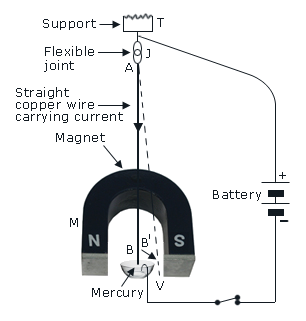The Kicking Wire Experiment
Q
Demonstrate the Force Acting on a Current-Carrying Conductor Placed in a Magnetic Field?
Sol:
The Kicking Wire Experiment: A thick copper wire AB is suspended
vertically from a support T using a flexible joint J (Below figure). The lower end B of this wire is free
to move between the poles of a U–shaped magnet M. The lower end B of the wire touches the mercury surface kept in a shallow vessel V so that it can move when a force acts on it. The positive terminal of a
battery is connected to end A of the wire. The circuit is completed by dipping another wire from the battery's negative
terminal into the mercury pool, as shown in figure. We know that mercury is a liquid which is a
good conductor of electricity, so the circuit is completed through mercury contained in vessel V.
On pressing the switch, a current flows in the wire AB vertically downward
direction. The wire AB is kicked in the forward direction (towards south), and its lower end B reaches
position B' so that the wire comes to the new position AB', as shown by the dotted line in figure 16. When the lower
end B of the hanging wire comes forward to B', its contact with the mercury surface is broken due to which the
circuit breaks and current stops flowing in the wire AB. Since no current flows in the wire, no force acts on it in this position and it falls back to its original position. As soon as the wire falls back, its lower
end again touches the mercury surface, the current starts flowing in the wire, and it is kicked again. This action is
repeated as long as the current is passed in wire AB. It should be noted that the current carrying wire is
kicked forward because a force is exerted on it by the magnetic field of the U–shaped magnet. From this
experiment we conclude that when a current carrying conductor is placed in a magnetic field, a
mechanical force is exerted on the conductor making it move.

If we reverse the direction of current in the wire AB so that it flows in the vertically
upward direction from B to A, then the wire swings in the backward direction (towards north). This means that
the direction of the force on the current carrying wire has been reversed. From this we conclude that the
direction of the force on a current carrying conductor placed in a magnetic field can be reversed by reversing the
direction of current the flowing in the conductor. Keeping the direction of current unchanged, if we
reverse the direction of magnetic field applied in figure by turning the magnet M so that its poles are
reversed, even then "the wire swings backwards showing the direction of force acting on it has been
reversed. Thus, the direction of the force on a current carrying conductor placed in a magnetic field can
also be reversed by reversing the direction of the magnetic field.